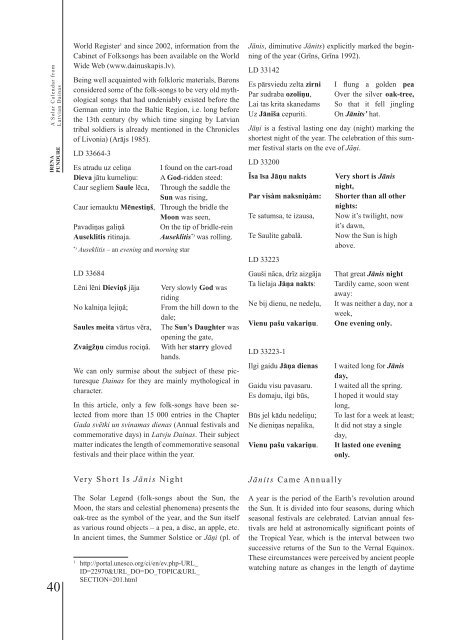BALTICA10
BALTICA10
BALTICA10
Create successful ePaper yourself
Turn your PDF publications into a flip-book with our unique Google optimized e-Paper software.
A Solar Calendar from<br />
Latvian Dainas<br />
IRENA<br />
PUNDURE<br />
World Register 1 and since 2002, information from the<br />
Cabinet of Folksongs has been available on the World<br />
Wide Web (www.dainuskapis.lv).<br />
Being well acquainted with folkloric materials, Barons<br />
considered some of the folk-songs to be very old mythological<br />
songs that had undeniably existed before the<br />
German entry into the Baltic Region, i.e. long before<br />
the 13th century (by which time singing by Latvian<br />
tribal soldiers is already mentioned in the Chronicles<br />
of Livonia) (Arājs 1985).<br />
LD 33664-3<br />
Es atradu uz celiņa I found on the cart-road<br />
Dieva jātu kumeliņu: A God-ridden steed:<br />
Caur segliem Saule lēca, Through the saddle the<br />
Sun was rising,<br />
Caur iemauktu Mēnestiņš, Through the bridle the<br />
Moon was seen,<br />
Pavadiņas galiņâ On the tip of bridle-rein<br />
Auseklitis ritinaja. Auseklitis *) was rolling.<br />
*)<br />
Auseklitis – an evening and morning star<br />
LD 33684<br />
Lēni lēni Dieviņš jāja<br />
No kalniņa lejiņâ;<br />
Saules meita vārtus vēra,<br />
Zvaigžņu cimdus rociņâ.<br />
Very slowly God was<br />
riding<br />
From the hill down to the<br />
dale;<br />
The Sun’s Daughter was<br />
opening the gate,<br />
With her starry gloved<br />
hands.<br />
We can only surmise about the subject of these picturesque<br />
Dainas for they are mainly mythological in<br />
character.<br />
In this article, only a few folk-songs have been selected<br />
from more than 15 000 entries in the Chapter<br />
Gada svētki un svinamas dienas (Annual festivals and<br />
commemorative days) in Latvju Dainas. Their subject<br />
matter indicates the length of commemorative seasonal<br />
festivals and their place within the year.<br />
Jānis, diminutive Jānits) explicitly marked the beginning<br />
of the year (Grīns, Grīna 1992).<br />
LD 33142<br />
Es pārsviedu zelta zirni<br />
Par sudraba ozoliņu,<br />
Lai tas krita skanedams<br />
Uz Jāniša cepuriti.<br />
I flung a golden pea<br />
Over the silver oak-tree,<br />
So that it fell jingling<br />
On Jānits’ hat.<br />
Jāņi is a festival lasting one day (night) marking the<br />
shortest night of the year. The celebration of this summer<br />
festival starts on the eve of Jāņi.<br />
LD 33200<br />
Īsa īsa Jāņu nakts<br />
Par visàm naksniņàm:<br />
Te satumsa, te izausa,<br />
Te Saulite gabalâ.<br />
LD 33223<br />
Gauši nāca, drīz aizgāja<br />
Ta lielaja Jāņa nakts:<br />
Ne bij dienu, ne nedeļu,<br />
Vienu pašu vakariņu.<br />
LD 33223-1<br />
Ilgi gaidu Jāņa dienas<br />
Gaidu visu pavasaru.<br />
Es domaju, ilgi būs,<br />
Būs jel kādu nedeliņu;<br />
Ne dieniņas nepalika,<br />
Vienu pašu vakariņu.<br />
Very short is Jānis<br />
night,<br />
Shorter than all other<br />
nights:<br />
Now it’s twilight, now<br />
it’s dawn,<br />
Now the Sun is high<br />
above.<br />
That great Jānis night<br />
Tardily came, soon went<br />
away:<br />
It was neither a day, nor a<br />
week,<br />
One evening only.<br />
I waited long for Jānis<br />
day,<br />
I waited all the spring.<br />
I hoped it would stay<br />
long,<br />
To last for a week at least;<br />
It did not stay a single<br />
day,<br />
It lasted one evening<br />
only.<br />
40<br />
Very Short Is Jānis Night<br />
The Solar Legend (folk-songs about the Sun, the<br />
Moon, the stars and celestial phenomena) presents the<br />
oak-tree as the symbol of the year, and the Sun itself<br />
as various round objects – a pea, a disc, an apple, etc.<br />
In ancient times, the Summer Solstice or Jāņi (pl. of<br />
1<br />
http://portal.unesco.org/ci/en/ev.php-URL_<br />
ID=22970&URL_DO=DO_TOPIC&URL_<br />
SECTION=201.html<br />
Jānits Came Annually<br />
A year is the period of the Earth’s revolution around<br />
the Sun. It is divided into four seasons, during which<br />
seasonal festivals are celebrated. Latvian annual festivals<br />
are held at astronomically significant points of<br />
the Tropical Year, which is the interval between two<br />
successive returns of the Sun to the Vernal Equinox.<br />
These circumstances were perceived by ancient people<br />
watching nature as changes in the length of daytime
















